San Diego Base Guides
About San Diego
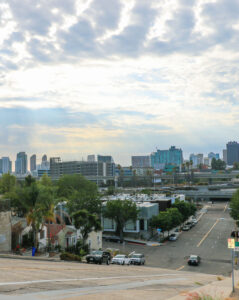
Wax up those surfboards and grab your sunscreen—you're headed to Cali, brah! San Diego, California, has been dubbed "America's Finest City," and it's easy to see why. A near-perfect climate, 70 miles of pristine Pacific coastline, fantastic scenery, countless family-friendly activities, outdoor adventures aplenty, gnarly surfing, and world-class golfing all make an assignment to San Diego one that military families cherish and help explain why so many choose to retire in the area.
Southern California is known for both mellow weather and mellow people. Inland towns can experience warmer temperatures, but the coastal regions maintain mild 65- to 80-degree temperatures year-round, with breezes coming in from the Pacific. The "May Gray" and "June Gloom" that the coastal regions "suffer" refer to the fog that rolls in during the early summer months. The mist keeps daytime temperatures low until the sun burns it off in the late afternoon. Otherwise, the area maintains a glorious, Mediterranean-like climate with continual ocean swells ideal for epic surfing.
Speaking of surfing, we should probably take a second to talk about surf culture. San Diego is known for some of the best beaches for surfing, and a reverence for the sport's history is woven into everything from the food to the local dialect. Flip flops, shaggy hair, and untucked shirts are the norm. You'll often find locals taking lunch breaks on the beach or families catching a sunset after dinner. Whether you're a maverick or new to surfing, take a second to acquaint yourself with local surf etiquette before shredding. Be realistic about your abilities and find a beach that suits your skills. Also, invest in a wetsuit. This is not the Atlantic, and the water is chilly!
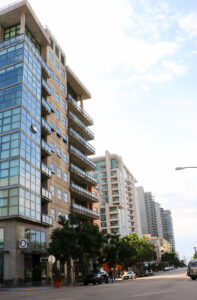
San Diego is home to several Navy, Marine Corps, and Coast Guard bases and is a large metropolitan area with a population of almost 1.4 million people. The central regions are densely populated, and a robust tourism industry adds to the congestion. While commuting is an issue, the roads and highways are well-planned, and bottlenecks are infrequent. Most San Diegans live by a "20-minute rule," which means they limit their commutes (or travel time to the beach) to 20 minutes or less. If you can't live near the water, situate yourself close to a freeway. Average commute times in San Diego are 25 to 30 minutes. Traffic does pick up considerably during tourist season (May through September), and parking can be troublesome near most destinations and beaches. Touring up and down the coast is made easy by the Coaster Train and the Amtrak Surfliner.
If you're not enjoying the gorgeous beaches and picturesque hiking trails, you can try the San Diego Zoo and Safari Park, LEGO-LAND, Balboa Park, the USS Midway Museum, or the Birch Aquarium. And don't forget that San Diego has a dining and beer scene that is the stuff of any respectable epicurean's dreams. Some of the most fantastic tourist spots on the West Coast are within a few hours' drive from San Diego. Temecula's Wine Country, Palm Springs, Borrego Springs, Disneyland in Anaheim, Los Angeles, and Joshua Tree National Park are all just an hour or two away. The Pacific Coast Highway starts at Dana Point in Orange County and can take you as far as your heart desires to up the scenic California coastline. You can head into the nearby mountains for hiking, camping (or glamping), or exploring the desert. Mexico is just across the border to the south, and you can fill your cultural cup—and your stomach— in Tijuana, Ensenada, or Valle de Guadalupe. Pick a destination and go on an adventure! The abundance of "memory-making" excursions is one of California's most fabulous perks—and certainly something you won't experience at many other duty stations.
FINDING A HOME
The first step in choosing where to live is to determine your priorities. Some folks need a little breathing room and look to live inland, away from some of the hustle and bustle. Others are okay with sacrificing space and privacy for living close to all the action of downtown or near the water. Be realistic with your priorities and sensitive to your budget. Once you determine your priorities, an experienced real estate agent can help you narrow down candidates for your new neighborhood!
Pro tip: If you come armed with this info before chatting with a real estate agent, they’ll have an enormous leg up in helping you find a home quickly. Efficiency and knowledge are crucial in this hyper-competitive real estate market.
HOME SIZE
Typically, Southern California homes are between two and three bedrooms, max. Most are built in the Spanish stucco style with red-tiled roofs. Some of the newer subdivisions have been constructed with modern families in mind, meaning you can find more than three bedrooms and slightly larger yards. House sizes shrink, and prices increase as you get closer to the water. Homes closer to the coast probably won’t have central A/C, but if you’re inland, you will want home cooling. If living close to the beach is a priority for you, don’t be afraid to look into condos or townhouses, many of which have pools and community amenities that can supplement indoor living space. The weather in San Diego is so lovely that you’ll want to be outside year-round anyway.
HOME PRICE
Many factors unique to California could potentially price you out of a neighborhood before you even start touring homes, so let’s look into what you need to know. San Diego is a pricey market, and the cost of living in California is higher than the national average. There is also a competitive real estate market, where bidding wars and above-asking-price cash offers are common. Home values change rapidly in this market, so ask your real estate agent for local market analysis. Generally speaking, you’ll be paying more per square foot the closer you are to the water.
Mello-Roos
You’ll need to get acquainted with a tax called Mello-Roos if you plan on buying a home in California. This Mello-Roos tax is above and beyond your typical property tax and can sometimes be upwards of $500 per month. The fees add up, and you could be spending well above your BAH. Long story short, some communities have the designation of a Community Facility District (CFD), and they impose an additional property tax to help pay for schools, roads, utilities, and services like police and fire protection. Again, an experienced real estate agent can help.
Utilities
Be sure to identify whether or not your potential home has air conditioning. Remember that utility bills for homes off post can routinely exceed $300. Pay close attention to this as you search farther inland. Living near the coast gets you the coastal breezes, so most people say that not having A/C here isn’t a deal-breaker.
HOAs
Homeowners Associations are the norm for most subdivisions, but also be on the lookout for community and city-wide HOAs. That sparkly, new neighborhood with a fitness center, pool, and meticulously kept golf course is paid for somehow...
SCHOOLS
Most servicemembers without children will probably just want to be as close to the water as possible. Those with children will likely look at communities farther inland. Online school ratings will not always show the entire picture, so it’s essential to do more extensive research. Look at the school’s or district’s report card from the California Department of Education. Interview potential schools. Take into account all factors that could influence test scores but aren’t necessarily reflective of the quality of education (i.e., a high percentage of students whose primary language isn’t English). There are several options for education models in California, and we’ve identified some schools in each area that military spouses recommend.
Traditional Public Schools
The California Department of Education operates traditional public schools. Students who reside within a school zone can attend their neighborhood school. Still, California public schools also offer open enrollment and intradistrict choice, meaning your child can attend any school inside or outside the district upon approval and space availability. Students at low-performing schools can also attend a different school in their district. Many public high schools are considered “schools of choice,” where any student in the district can select
which school to attend. A lottery is held if there are too many applications. Some schools are fantastic and offer truly incredible student experiences—you won’t find surfing as an elective at many other duty stations.
Charter Schools
Charter schools are public schools that have private oversight and come in a variety of educational models. The charter schools can offer traditional, site-based instruction (meaning your child goes to a classroom daily), independent study programs (parents are provided the curriculum and materials for homeschooling), or a hybrid of both models (one day of classroom instruction per week). Charters have zoned districts, where your child may attend if you live within the district, or you can also take advantage of California’s intradistrict choice to apply for a school in another district.
Magnet Schools
A magnet school in the local public school system operates under the same oversight and school board as public schools. Magnet schools typically focus on STEM (Science, Technology, Engineering, and Math), the arts, or vocational paths. There are many Montessori magnet schools in California. Magnet schools typically accept a small percentage of applicants. Therefore lotteries are common, but living within the school’s assigned district can help with acceptance.
Private Schools
As always, you may opt for a private school education for your child if the neighborhood schools don’t excite you. Private schooling is a pricey option but viable for some. Private schools can be religious or nonsectarian and are popular for preschool.
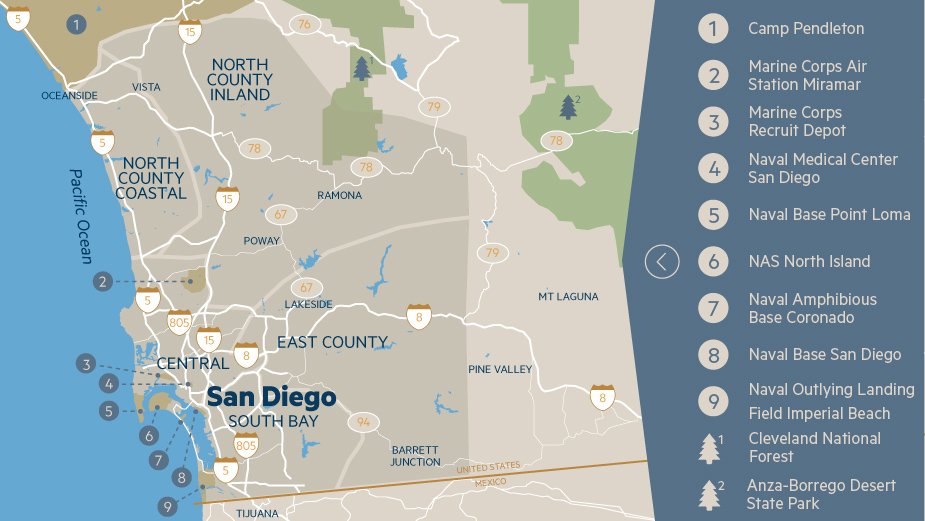
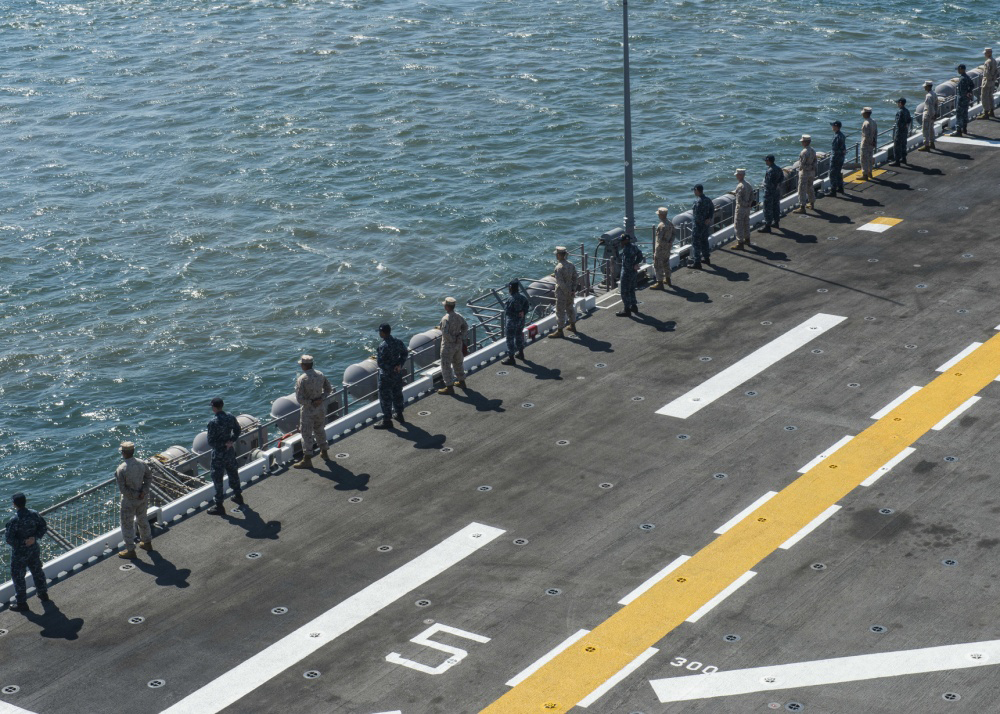
KEY CONTACTS
Liberty Military Housing
2625 Le Hardy St. #3544
San Diego, CA 92136
PH: (858) 633-2105
Fleet and Family Support Center
3005 Corbina Alley
Bldg. #259
San Diego, CA 92136-0000
PH: (619) 556-7404
School Liaison Office
937 North Harbor Dr.
Building #1
San Diego, CA 92132
PH: (619) 532-1034
Serving incoming families who require general information about metro San Diego, Murphy Canyon Area, and San Diego City
PH: (619) 247-9082
Serving South San Diego, Lemon Grove, La Mesa, Spring Valley, Chula Vista, Sweetwater, & El Centro
Most installation services will be available Monday through Friday, 9:00am to 4:00pm. As always, call first to confirm hours and availability of services.
Helpful hint: Contact these offices early in the week during the morning time
Naval Base San Diego
Naval Base San Diego is the home port for the Pacific Fleet, and there are almost 50 Navy ships, a Coast Guard cutter, and many auxiliary vessels docked in San Diego Bay. Lovely, temperate, and picturesque San Diego is home to several military installations and has one of the nation’s largest veteran populations. There are 213 individual commands on 1,600 acres of land and 326 acres of water. Naval Base San Diego falls under the headquarters umbrella of the Navy Region Southwest (NRSW), which is in charge of shore installation management for California, Nevada, Utah, Arizona, New Mexico, and Colorado. The NRSW headquarters is just a few miles north of base in downtown San Diego.
Naval Base San Diego is on San Diego Bay, directly across from Coronado. It occupies what was once a civilian shipbuilding coalition where several companies set up shop in 1918. The decline in profits after World War I prompted the sale of the land to the U.S. Navy, and by 1922 the site was a functioning Navy repair facility. The base has had several missions and was renamed half a dozen times, but it is most commonly known as “32nd Street” because of its location. The high cost of living and housing expenses drive a lot of families to try to live on base. Several privatized base housing communities are located throughout San Diego, and some are even oceanfront.
While base housing is a popular choice, there is usually a waitlist, and it is by no means the only way to go. There are generally two schools of thought on where to live in San Diego: Those with school-aged children or large families tend to look inland for larger homes and a lower price per square foot, while young couples, singles, or those with small children (or those willing to sacrifice home size for proximity to the water) try to live as close to the coast as possible. Even if you aren’t on the beach, you’ll want to try and position yourself close to a highway that can get you there quickly!
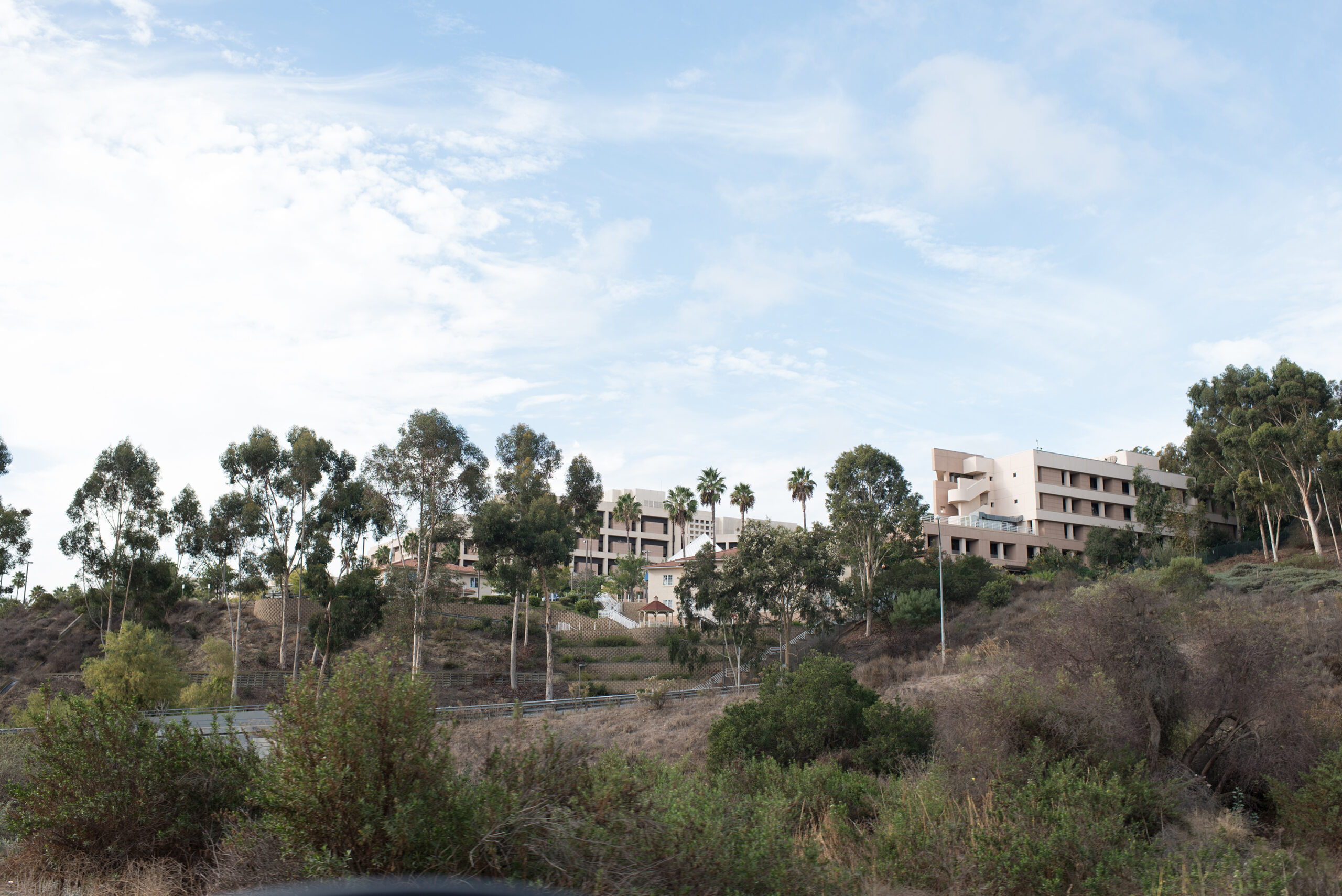
KEY CONTACTS
Liberty Military Housing
2625 Le Hardy St. #3544
San Diego, CA 92136
PH: (858) 633-2105
Fleet and Family Support Center
3005 Corbina Alley
Bldg. #259
San Diego, CA 92136-0000
PH: (619) 556-7404
School Liaison Office
937 North Harbor Dr.
Building #1
San Diego, CA 92132
PH: (619) 532-1034
Serving incoming families who require general information about metro San Diego, Murphy Canyon Area, and San Diego City
PH: (619) 247-9082
Serving South San Diego, Lemon Grove, La Mesa, Spring Valley, Chula Vista, Sweetwater, & El Centro
Most installation services will be available Monday through Friday, 9:00am to 4:00pm. As always, call first to confirm hours and availability of services.
Helpful hint: Contact these offices early in the week during the morning time
Naval Medical Center San Diego
“The Pride of Navy Medicine” is a downtown San Diego fixture and renowned landmark in the heart of Balboa Park. The medical complex has grown tremendously from its humble beginnings as a tent dispensary in 1914. At the onset of World War I, a generous portion of land in the park was lent to all branches of the military for barracks, training facilities, and medical care. After the war, a 17-acre parcel of land was given to the Navy to build a permanent hospital, and in 1922 a 204-bed hospital was opened. During World War II, the naval hospital was booming, and most buildings and grounds within Balboa Park were commandeered for use. Former U.S. Congressman Bob Wilson led a hard-fought campaign to acquire land and funding for a modern medical facility. The current Naval Medical Center San Diego (NMCSD) is the result of his efforts. Congress approved almost $300 million to build a new complex, and the Bob Wilson Naval Hospital was opened in 1988—although locals and service members know it simply as “Balboa Hospital.”
NMCSD is renowned for its quality care and state-of-the-art facilities. It occupies most of the southeast corner (78.4 acres) of Balboa Park and is staffed by more than 6,500 military, civilian, contractor, and volunteer personnel. It’s also a premier teaching hospital and referral center for the Armed Forces. Currently the only Navy Medicine Amputee Center in the Western Pacific, the medical center also boasts a virtual reality lab for PTSD treatment. There are several outlying clinics in the NMCSD network, and almost 100,000 dependents are enrolled beneficiaries.
Housing options are abundant in San Diego. Being near the beach is optimal for most, but not the only choice. The cost of living, utilities, and home prices in California are much higher than in most other areas of the country. You’ll spend more (and get less) the closer you are to the water. Here’s the bottom line: Being stationed in San Diego provides access to stunning beaches, a near-perfect climate, friendly people with a laid-back beachy vibe, outdoor activities aplenty, travel to some of the most unique locales on the West Coast, and truly unique lifestyle that you will cherish forever.

KEY CONTACTS
Liberty Military Housing
2625 LeHardy St.
Bldg. 3544, 1st Floor
San Diego, CA 92136
PH: (858) 633-2105
Fleet & Family Support Center
318 Saufley Rd.
Bldg. 318
San Diego, CA 92118
PH: (619) 545-6071
School Liaison Officer (NRSW)
937 N. Harbor Dr.
San Diego, CA 92136
PH: (619) 532-1034
Most installation services will be available Monday through Friday, 9:00am to 4:00pm. As always, call first to confirm hours and availability of services.
Helpful hint: Contact these offices early in the week during the morning time
Naval Amphibious Base Coronado
Naval Amphibious Base Coronado, “Amphib” or “NAB” to the cool kids, is one of two Navy installations on the breathtaking Coronado Island. NAB is probably most renowned for being home to the Navy’s special and expeditionary warfare training, or more specifically, the West Coast SEAL Teams and Special Boat Units. NAB supports nearly 30 tenant commands and occupies approximately 1,000 acres of land composed of beaches; a Lest Tern preserve (it’s a bird), a marina, highly coveted base housing, and a state park. Naval Air Station North Island lies to the north, and Imperial Beach lies to the south.
Highway 75 divides the base into the Oceanside and the Bayside. The Bayside exists because of a special project from the early 1940s. This area of Coronado was once underwater, but in the military’s efforts to create more training space (shore) and deeper water for docking large ships, the bay was dredged, and the fill materials were then used to create more land for training.
Low inventory and high prices drive a lot of military families to look for housing options in nearby San Diego. Nearby NAS North Island is like a city in and of itself and offers all the amenities one can imagine. Base housing is also available on NAB with two- and three-bedroom homes, although there’s usually a long wait list. The Coronado Bridge is one route for commuting to and from NAS North Island, but going south through Imperial Beach is also an option.

KEY CONTACTS
Liberty Military Housing
2625 Le Hardy St. #3544
San Diego, CA 92136
PH: (858) 633-2105
Fleet & Family Support Center
318 Saufley Rd.
Bldg. 318
San Diego, CA 92118
PH: (619) 545-6071
School Liaison Officer (NRSW)
937 N. Harbor Dr.
San Diego, CA 92136
PH: (619) 532-1034
Most installation services will be available Monday through Friday, 9:00am to 4:00pm. As always, call first to confirm hours and availability of services.
Helpful hint: Contact these offices early in the week during the morning time
Naval Outlying Landing Field Imperial Beach
Naval Outlying Landing Field Imperial Beach (NOLF IB) is located in Imperial Beach and occupies over 1,200 acres of beautiful Southern California terrain. “The Helicopter Capital of the World” is the only exclusive-use naval helicopter airfield on the West Coast. Locals still refer to it as “Ream Field,” the name it was given while it was in the Army’s possession during the early 1900s. The landing field is primarily used for “touch-and-go landing” training and falls under the command of Naval Air Station North Island in nearby Coronado. Over 40 percent of the Navy’s helicopter pilots train at NOLF IB!
NOLF IB is a part of the South Bay community between Imperial Beach and the Mexican border. It’s nine miles south of the City of San Diego and is connected to Coronado by the Silver Strand Beach and Causeway. Almost half of NOLF’s 1,100 acres is a part of the Tijuana River National Estuarine Research Reserve, a haven for several endangered birds.

KEY CONTACTS
Liberty Military Housing
2625 Le Hardy St. #3544
San Diego, CA 92136
PH: (858) 633-2105
Family Readiness/Support
3800 Chosin Ave.
Bldg. 5 East
San Diego, CA 92140
PH: (619) 718-3763
School Liaison Office
3602 Hochmuth Ave.
Bldg. 6 East
San Diego, CA 92140
PH: (619) 524-8032
Most installation services will be available Monday through Friday, 9:00am to 4:00pm. As always, call first to confirm hours and availability of services.
Helpful hint: Contact these offices early in the week during the morning time
Marine Corps Recruit Depot
All young men from west of the Mississippi River with aspirations of becoming a “Devil Dog” will endure 12 formative weeks at the Marine Corps Recruit Depot San Diego. (Female recruits from the entire U.S. and male recruits from east of the Mississippi report to MCRD Parris Island in South Carolina.) “The Depot” trains over 21,000 Marine recruits each year. It is also home to the Marine Corps Recruiter School (for the entire Marine Corps) and the Drill Instructors’ School for the Western Recruiting Region. There is also a U.S. Coast Guard presence on board the Depot in the form of a Pacific Area Tactical Law Enforcement Team and the Maritime Safety and Security Team.
The Depot is located between Interstate 5 and San Diego Bay, just north of the San Diego International Airport. The base was officially established in 1923 and is on the National Register of Historic Places, along with 25 original buildings. It occupies 388 acres of prime San Diego real estate and is one of the largest employers in the county.

KEY CONTACTS
Liberty Military Housing
2625 LeHardy St.
Bldg. 3544, 1st Floor
San Diego, CA 92136
PH: (858) 633-2105
Fleet & Family Support Center
318 Saufley Rd.
Bldg. 318
San Diego, CA 92118
PH: (619) 545-6071
School Liaison Officer (NRSW)
937 N. Harbor Dr.
San Diego, CA 92136
PH: (619) 532-1034
Most installation services will be available Monday through Friday, 9:00am to 4:00pm. As always, call first to confirm hours and availability of services.
Helpful hint: Contact these offices early in the week during the morning time
Naval Air Station North Island
Congratulations! You’ve landed orders to one of the most envied duty stations in the United States! Naval Air Station North Island (NASNI), commonly referred to as “North Island,” occupies the entire north end of the Coronado peninsula in San Diego Bay. NAS North Island falls under the command of Naval Base Coronado, a consortium of eight naval bases, including the Naval Amphibious Base Coronado and Naval Outlying Landing Field Imperial Beach (NOLF). The “Birthplace of Naval Aviation” is home to several Navy aircraft carriers, over 20 aviation squadrons, and 80 additional tenant commands and activities. The Navy Aviation Depot also falls under the NASNI command and is the largest aerospace employer in San Diego. NAS North Island also operates two other airfields: NOLF Imperial Beach and Naval Auxiliary Landing Facility San Clemente, California.
North Island was originally an uninhabited sand flat that served as a playground for guests of a nearby resort hotel, the famous Hotel Del Coronado. Hunting and horseback riding were popular pastimes, and Glen Curtiss operated a flying school on North Island until the beginning of World War I. In 1917, Congress appropriated the land and commissioned two airfields. The Army Signal Corps operated Rockwell Field, and the Navy ran “Camp Trouble.” By 1937, the Army moved out, and the Navy took over the entire island.
In case you’re looking at a map and are confused by the terminology, we hope this helps: A body of water called the Spanish Bight once separated North Island from the city of Coronado. A bight is a naturally occurring curve or bend in the coastline, and the Spanish Bight was a shallow inlet between the two land masses. A causeway connected the true island to the city of Coronado, which was actually the northern end of an isthmus that continues down a stretch of land (Silver Strand) and terminates at Imperial Beach. Before World War II, the Navy dredged the bay and filled in the Spanish Bight, connecting North Island to Coronado. The land created by this provided more property for the Navy’s support facilities and deep water for the homeporting of large ships and aircraft carriers.
NAS North Island is like a city in and of itself and offers all the amenities one can imagine right on base. Base housing is available, with two- and three-bedroom homes, although there’s usually a long wait list. Low inventory and high prices drive a lot of military families to look for housing options in nearby San Diego. The Coronado Bridge is one route for commuting to and from NAS North Island, but going south through Imperial Beach is also an option.
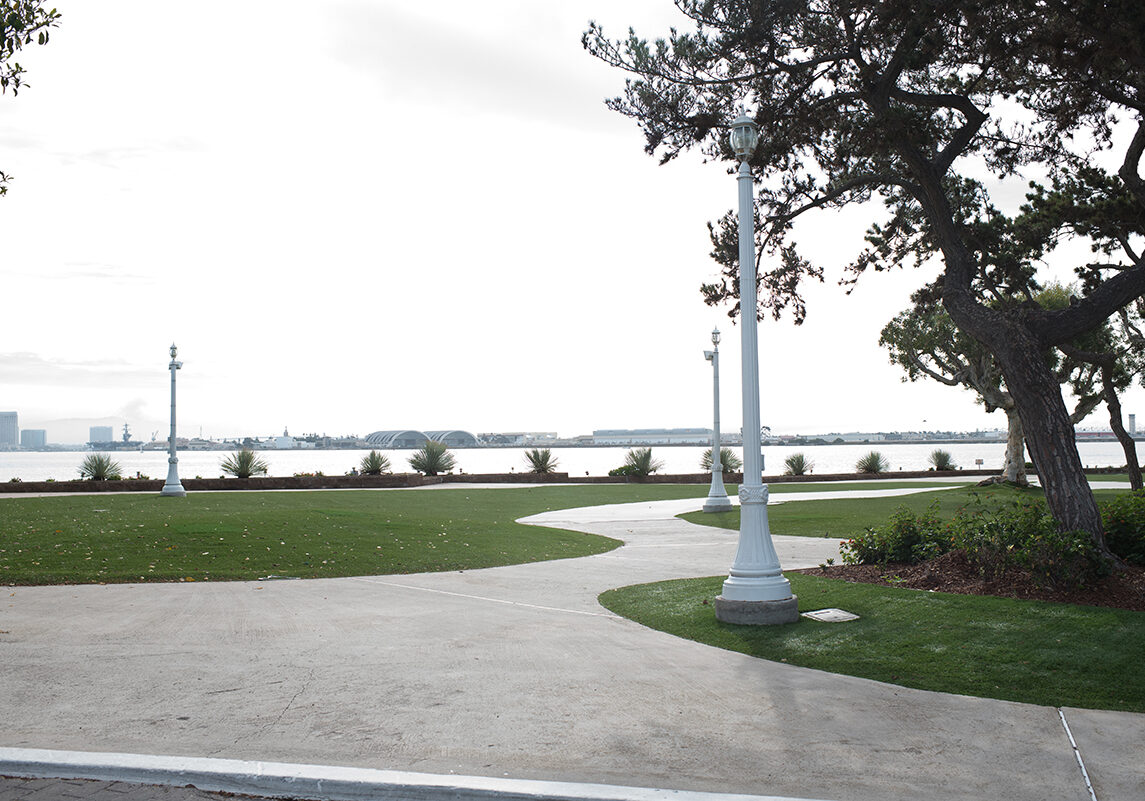
KEY CONTACTS
Liberty Military Housing
2625 Le Hardy St. #3544
San Diego, CA 92136
PH: (858) 633-2105
Fleet & Family Support Center NBPL
Dept. Code N91, Second Floor
140 Sylvester Rd.
Bldg. #211/#212
San Diego, CA 92106-3521
PH: (619) 556-7404
School Liaison Office
937 North Harbor Dr.
Building #1
San Diego, CA 92132
PH: (619) 532-1034
Most installation services will be available Monday through Friday, 9:00am to 4:00pm. As always, call first to confirm hours and availability of services.
Helpful hint: Contact these offices early in the week during the morning time
Naval Base Point Loma
Point Loma is a peninsula that guards Coronado and the entrance to San Diego Bay. The hills provide panoramic views of San Diego’s coastline, and the first Europeans to visit the area immediately saw its tactical potential. In 1797, the Spanish built the Castillo de Guijarros, named for the cobblestones that were plentiful on this rocky outcrop. English-speaking sailors later used these stones as ship ballasts, and the tip of the peninsula was dubbed “Ballast Point.” In 1852, roughly 1,400 acres of the southern portion of Point Loma were reserved for the U.S. military. It was first used by the Army as an artillery post, Fort Rosecrans, until 1959, when the land was transferred to the Navy.
Several organizations fall under the command of Naval Base Point Loma (NBPL), including Third Fleet, Naval Mine, and Anti-Submarine Warfare Command, Space and Naval Warfare Systems Command (SPAWAR), SPAWAR Systems Center, Fleet Intelligence Training Center Pacific, Tactical Training Group Pacific, Submarine Squadron ELEVEN, Commander Sealift Logistics Command Pacific, Submarine Training Center Pacific Detachment, seven submarines, a floating dry dock (ARCO), and the Navy’s Substance Abuse Rehabilitation Department (SARD). The headquarters for San Diego area Army Reserve components are also located here—so there is hope, Army folks!
Even during the Fort Rosecrans’ days, this was an enviable base, and there was never a shortage of applications for transfer or reenlistment. It was jokingly referred to as an “old soldier’s home” because of the high rate of those who retired and stuck around to live their golden years in sunny San Diego. Not much has changed. The mild climate, laid-back culture, stunning landscapes, and military-friendly atmosphere lead many to retire in the area. Many privatized military housing facilities are scattered throughout San Diego, and quite a few are coastal! Orders to NBPL are a hot commodity, and life in Southern California is dreamy.
You won’t find traditional beaches on Point Loma, but it is home to some great tidal pools. The peninsula is hilly with rocky cliffs, but the elevation provides breathtaking views of the Pacific Ocean to the west and beautiful sweeping views of San Diego Bay to the east. The hills of Point Loma provide one of the best vantage points to watch the annual migration of blue whales up the coast, and sport fishing here is legit. The northern portion of the peninsula is home to some of the oldest, most prestigious neighborhoods in San Diego.
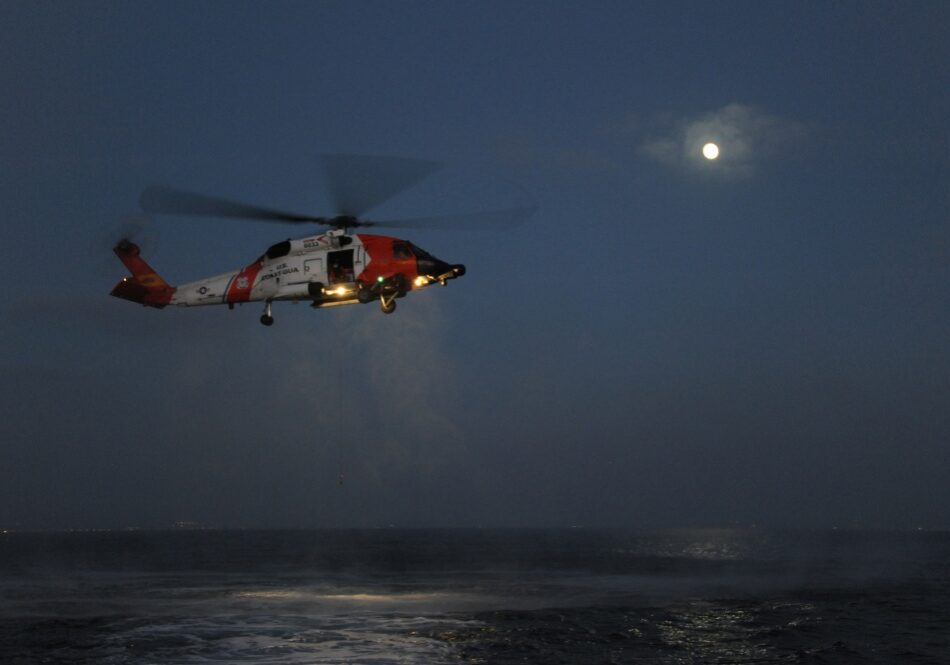
KEY CONTACTS
Liberty Military Housing
2625 Le Hardy St. #3544
San Diego, CA 92136
PH: (858) 633-2105
Fleet and Family Support Center
3005 Corbina Alley
Bldg. #259 & #263
San Diego, CA 92136-0000
PH: (619) 556-7404
School Liaison Office
937 North Harbor Dr.
Building #1
San Diego, CA 92132
PH: (619) 532-1034
Available by appointment
Serving South San Diego, Lemon Grove, La Mesa, Spring Valley, Chula Vista, Sweetwater, & El Centro
PH: (619) 247-9082
Most installation services will be available Monday through Friday, 9:00am to 4:00pm. As always, call first to confirm hours and availability of services.
Helpful hint: Contact these offices early in the week during the morning time
Coast Guard Air Station San Diego
Coast Guard Air Station San Diego (CGAS San Diego) is located directly across the street from Lindbergh Field, better known as the San Diego International Airport. Negotiations between the U.S. Government and the City of San Diego began in 1935 to construct the Air Station. CGAS San Diego was commissioned in April 1937 and, at the time, was the only Coast Guard Air Station in California. Since CGAS San Diego is located across the street from San Diego International Airport, fixed-wing aircraft attempting to reach CGAS from Lindbergh Field must cross a busy street to reach the Air Station.
CGAS San Diego is home to three MH-60T Jayhawk helicopters, and the adjacent Sector San Diego is home to two 41-foot Utility Boats, two 21-foot U.S. Coast Guard (USCG) rigid hull inflatable boats, one 25-foot RB-HS, and three 25-foot RB-S. Two 87-foot USCG Coastal Patrol Boats are also housed here. Those assigned here will likely participate in Coast Guard Search and Rescue operations and Maritime Law Enforcement.
There is no family housing located at Coast Guard Air Station San Diego. However, families may apply for housing on nearby military installations. An assignment to CGAS San Diego is an excellent opportunity to live in one of the many off-base neighborhoods and experience San Diego as a local!
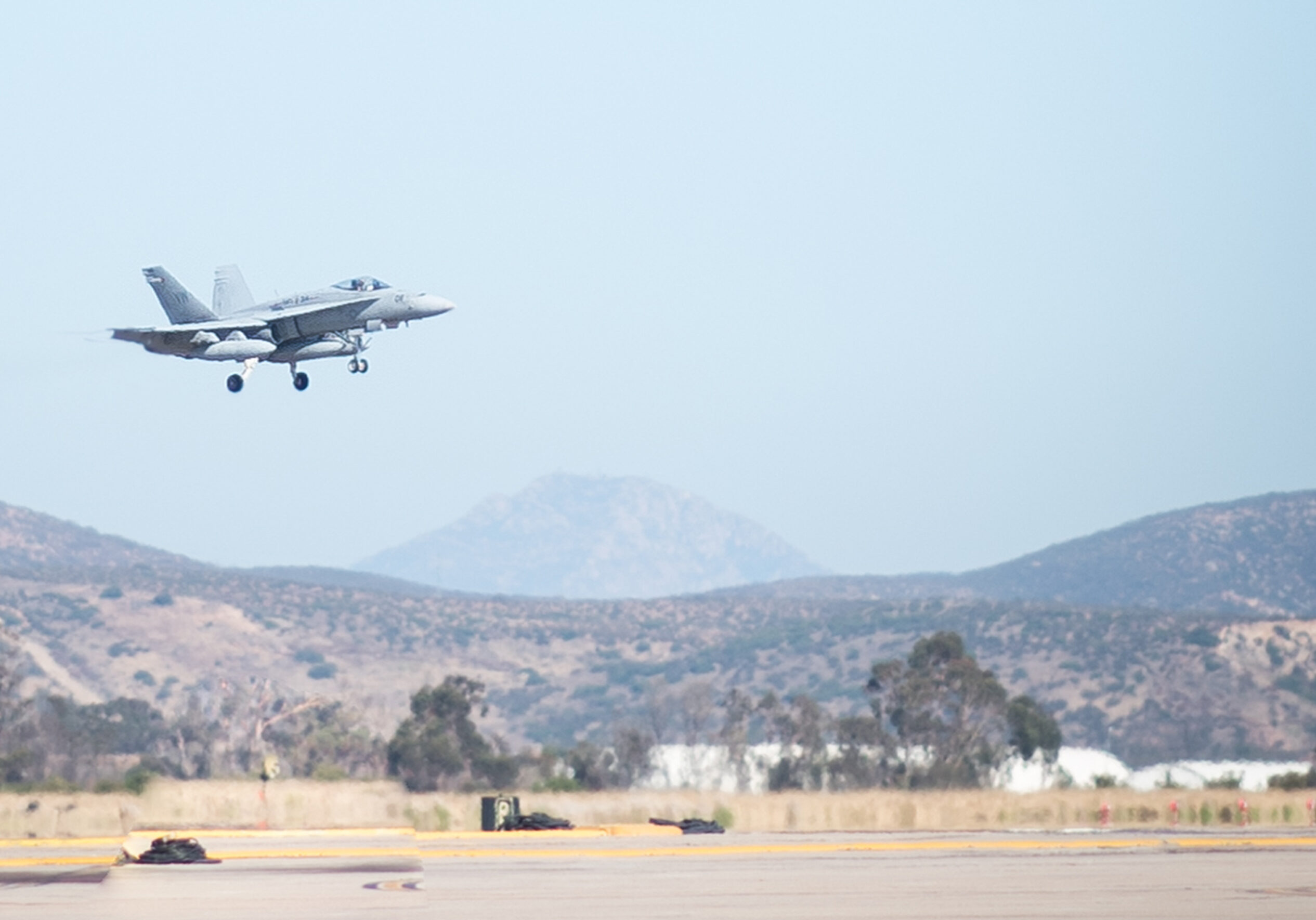
KEY CONTACTS
Family Housing Office for MCAS Miramar
Liberty Military Housing
2625 Le Hardy St. #3544
San Diego, CA 92136
PH: (858) 633-2105
Family Readiness Marine and Family Programs
2525 Bauer Rd, San Diego, CA 92126
PH: (858) 307-4918
School Liaison Office
Building #8630
Marine Corps Air Station Miramar
San Diego, CA 92145
PH: (858) 307-6633
Most installation services will be available Monday through Friday, 9:00am to 4:00pm. As always, call first to confirm hours and availability of services.
Helpful hint: Contact these offices early in the week during the morning time
Marine Corps Air Station Miramar
One of the country's most desirable Marine Corps stations is Marine Corps Air Station Miramar. Miramar, for short, is located in beautiful San Diego, California, right in the center of a web of ten Navy and Marine installations. MCAS Miramar is primarily home to the 3rd Marine Aircraft Wing (MAW). The impressive array of aircraft aboard Miramar includes the F/A-18D Hornet, the Sikorsky CH-53E Super Stallion heavy-lift helicopter, the MV-22 Osprey tilt-rotor helicopter, and the KC-130 Hercules. You can see all these aircraft and more at the annual Miramar Air Show, which attracts visitors worldwide.
Miramar's history dates back to 1917 when it was a U.S. Army Infantry training base, Camp Kearny. Since then, this prized land has changed hands many times. After World War I, the Navy occupied the area, ending the era of Camp Kearny. During World War II, it was home to both Sailors and Marines for a little over a year, but in 1947 the Marines packed up and moved to El Toro, California. The former Naval Air Station Miramar is probably most well-known for the famous fighter pilot school TOP GUN, which is how the area earned the nickname "Fightertown, U.S.A." But the Navy moved away in the late '90s, and the Marines returned from El Toro in 1997.
Looking at relocating?
Enter your information below and we will reach out to help the process.
7 Reasons You Should Consider Buying a Home
1. TAX ADVANTAGES
To encourage homeownership, the IRS has provided many tax breaks for owning a home. Credits may be available for specific home improvements, such as using clean energy or for qualified first-time home buyers. The way most homeowners see those advantages is through income tax itemization and deductions like mortgage interest and real estate taxes.
2. STABALIZE MONTHLY HOME COSTS
Owning your own house is one of the safest bets on stabilizing your monthly home costs. There’s no worry of rent getting increased significantly after each year of living in someone else’s home. Additionally, when you answer to yourself, there is no worry of landlord changes or unexpected lease termination.
3. HOUSE HACKING
Generally speaking, house hacking is a smart strategy that involves renting out a portion of your primary residence as a means of generating income to offset your own living expenses. Think turning your finished basement or mother-in-law quarters into an AirBnB! Or consider purchasing a multi-unit duplex or triplex: live on one side and rent out the other! If your home making money while you’re living in it doesn’t sound like your thing, there’s always renting it out after you PCS as an income generating investment property.
4. Increased Privacy
Generally speaking, house hacking is a smart strategy that involves renting out a portion of your primary residence as a means of generating income to offset your own living expenses. Think turning your finished basement or mother-in-law quarters into an AirBnB! Or consider purchasing a multi-unit duplex or triplex: live on one side and rent out the other! If your home making money while you’re living in it doesn’t sound like your thing, there’s always renting it out after you PCS as an income generating investment property.
5. Pets Are Welcome!
For those who choose to rent instead of buying, it can be extremely difficult to find rentals who allow for your
four-legged, furry friends. Landlords often require hefty pet deposits or place heavy restrictions on the number of pets and breeds they allow—if they will even allow pets. When considering quality of life, including beloved pets and the indoor and outdoor space available to them matters. Having the flexibility to include ALL members of your family as a homeowner is priceless!
6. Pride of Ownership
One of the greatest benefits of owning your own home is the pride of ownership that comes along with it. Not only are homeowners more inclined to take good care of their investment with routine maintenance and cleaning, but also they are free to make design choices ranging from hanging artwork on the walls, to paint colors, to customization of closets, electronics, and more. As military families who relocate frequently, having your home reflect who you really are feels important.
7. Safe and Stable Long Term Investment + Forced Savings
Owning a home has historically been one of the safest, lowest risk financial investments that tends to have long-term stability and success. As your home value appreciates and your mortgage balance decreases, what’s left is growing equity with an eventual paid off home. Making a monthly house payment is akin to setting aside a specific amount each month into a savings account—it’s a little difficult to access in the moment, but over time it can build into something significant in the form of equity.

FIVE RESOURCES TO HELP YOU IN YOUR RELOCATION PROCESS

Your PCS is underway!
The home buying and moving transition process has begun. Now what? If it feels like there are a million things to do, don’t fret because you don’t have to do them all yourself. During the relocation process, there are many service providers that can assist you in making your move a smooth one.
Consider these five resources to help you in the process
1. MOVING COMPANIES
Sure, the military offers transportation and relocation services, but many service members decide to coordinate the transfer of household goods themselves. Not only can you often earn money on the difference between moving costs and weight allowances, but you can be assured that you have more control over your belongings. Services that moving companies offer can range from delivery of boxes and pods for the “you-pack” model all the way to full-service logistics companies that will do all of the packing, loading, driving, and unpacking for you.
2. STORAGE
Whether you need to store your household goods for a few weeks until you close on your home or you decide that you have more stuff than square footage, storage companies abound. Sizes, conditions, and contracts vary widely so be sure to do your homework before you commit. Particularly in climates with extreme cold, heat, or humidity, it is important to consider using only climate-controlled storage to ensure the protection of your furniture and temporarily unused items.
3. TEMPORARY HOUSING
It is not uncommon for there to be a short gap of time during a military move between when you arrive at your new duty station and your new home being available to inhabit. No longer are hotels the only option for sticking out a few days or weeks during the wait. Vacation Rentals by Owner (VRBO) and Airbnb are great options to make you feel more at home while you wait for your home. In fact, why not take advantage of seeing your new city through the eyes of a tourist? Find a location near new local attractions and dining and enjoy a few days of getting to know the lay of the land.
4. USPS/IRS
Once you get settled in at your new home, it’s important that you alert agencies that will make sure your current and up-to-date address is on file. The United States Postal Service (USPS) and the Internal Revenue Service (IRS) are two of the most important and by doing so, any important mail or documents in your name should be forwarded or sent along to your new address. It’s also a good idea to notify banks, credit card companies, and other debt collectors of a change of address. These days nearly all of these transactions can be handled online.
5. DISCARD & DONATE SERVICES
No matter how much you purge, toss, organize, minimize, or donate before you pack up the moving truck, it never fails that after you get unpacked on the other side there seems to be more stuff to declutter. Discard and donate services can help with this. Many are a phone call away and will happily come to your residence for a pickup. Others are structured where you simply drop off at a store. A lot of these services are charitable organizations and will offer you documentation for your own taxes based on your donation. It’s a win-win: you downsize by donating, and someone else benefits from your use of your items.

